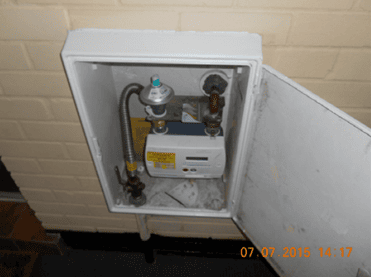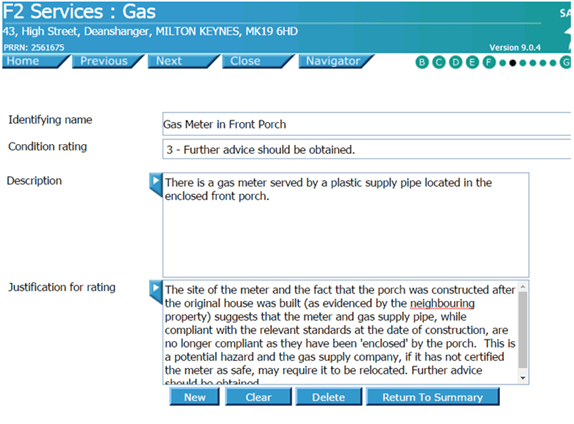Inside Gas Meters (Part 2).

Following on from ‘inside gas meters (part 1), some readers have raised a number of interesting issues.
- When is a gas meter ‘inside’? Does this include an unheated integral garage or where the meter has been enclosed by a porch or a conservatory?
- If an integral garage has been converted to a habitable room, would the gas meter have been checked during the building regulation approval process?
- Regarding meter readers carrying out safety checks, what happens when a customer provides their own readings?
One reader, who used to be a gas engineer under the CORGI scheme, thought surveyors would not be expected to know whether a supply pipe should be in metal or MDPE. Instead, it should be the gas engineer who services the appliances who flags up when the gas service pipe is incorrect. According to him, ‘The surveyor should stick to what she/he is able to do and that is awarding a CR3 if there is not a valid test certificate for the installation’.
We think all of these points are relevant and appropriate. Getting feedback like this helps us all reflect on our practice and make sure we are giving the right advice to our clients. To be clear on what we think should be done:
- Practitioners should ask for evidence that ALL parts of the gas service system have been safety checked within the last 12 months (and this includes all gas appliances, gas supply pipes and meters). Where evidence is not provided during the inspection, then a ‘condition rating 3: further investigation’ should be allocated to the gas supply element (G2 in RICS Home Surveys and F2 in the SAVA Home Condition Survey).
- Regardless of whether the gas service has been safety checked, all parts of the gas service should still be visually inspected by the surveyor and any unusual features recorded in the site notes. This will help support the later condition rating decision. In this particular case, a gas meter with a plastic supply pipe and in a PVC housing on the ‘inside’ of the property should be regarded as an unusual feature.
Which then leads to the question – “What is considered to be on the ‘inside’ of the property?”
Unpicking the regulations around domestic gas supply
Once you start considering all the legislation relating to the supply of gas into domestic property it can all get a bit geeky.
The key pieces of health and safety legislation covering gas supply are:
- Gas Safety (Management) Regulations 1996 –GSMR
- Pipeline Safety Regulations 1996 (PSR)
They are published by the Health and Safety executive under the Health and Safety at Work Act.
Responsibility for enforcing health and safety law for gas supply management, transportation and storage forms part of the role of the Gas and Pipelines Unit in HSE’s Hazardous Industries Directorate.
The Gas Safety (Management) Regulations 1996 (GSMR) apply to the conveyance of natural gas (methane) through pipes to consumers, both domestic and commercial, and cover four main areas:
1. The safe management of gas flow through a network, particularly those parts supplying domestic consumers, and a duty to minimise the risk of a gas supply emergency.
2. Arrangements for dealing with supply emergencies.
3. Arrangements for dealing with reported gas escapes and gas incidents.
4. Gas composition
The GSMR deals with the management of the flow of gas through the network, but it is the Pipelines Safety Regulations 1996 (PSR) which are principally concerned with the integrity of the pipeline network and at securing safety in the design, construction, installation, operation, maintenance and decommissioning of pipelines.
PSR imposes general duties in relation to all relevant pipelines and additional duties with regard to major accident hazard pipelines.
The PSR have a supporting Approved Code of Practice (ACOP), again published by the Health and Safety Commission.
A quick glance around the internet quickly confirms that all of these regulations were not written with the lay person, or even, it could be argued, the average gas engineer, in mind. As with all legislation, they are not an easy read.
Consequently industry has stepped up to the plate to produce technical guidance that translates legislative requirement into practical application. “Industry” can refer to both the infrastructure and network providers and professional and regulatory bodies such as Gas Safe and the professional body for gas professionals, the Institution of Gas Engineers and Managers.
The HSE in the ACOP document actually refers to the technical guidance produced by the Institution of Gas Engineers (IGE/TD/4). Of particular note from this guidance is:-
- That if a service is installed through a wall, floor or void between floor or ceiling then it should be of non combustible material
- A PE service should not enter any building, including a garage or enclosed structure, unless enclosed in a gas tight metallic sleeve.
GTC is one of the gas distribution network operators and also provides gas supplies and meters for house builders. They, in turn, produce a technical guide called “Building Over External Gas Pipes” (GG-TGI-IG-0037).
When GTC provides the gas supply to a new property the has service pipe connecting the supply to the main in the street to the gas meter at the property will be a polyethylene pipe (PE). They will use a preformed sleeve to provide a conduit that takes the PE pipe from the horizontal to the vertical terminating at the gas meter box, which for new build properties will be located on the outside. This is a standard construction technique for the supplying external gas meter. It should be noted that the PE, although used for the external gas supply, is a combustible material. Also, it is worth noting, that the has service pipe will remain the ownership of the gas distribution network operator.
If an external meter box with a PE pipe supply is ‘contained’ in anyway, for instance by building a porch at a later date and thus covering the meter box,then the PE pipe is then deemed to be underneath the building and thus no longer compliant.
The guidance produced by GTC states that should any form of structure be built that ‘contains’ the external supply pipe and the meter box (when it was originally designed to be an external meter box) then, in the event that they have not been asked to move the gas supply, they will:-
- Arrange for immediate disconnection if the gas supply is at medium pressure; or
- Arrange for disconnection after 30 days if the supply is Low Pressure (that is less than 75 mbar) allowing for the occupier to arrange for the relocation of the meter box.
Outlet installation pipework, that is the pipework from the meter box going into the property, is the responsibility of the property owner and therefore a Gas Safe Registered Engineer will need to make any changes to that part of the system.
How should a surveyor report on an internal gas meter? Alarm bells should ring in the following situations:
Where a meter was originally designed to be ‘outside’ but has now been covered over/ contained within, for example :
- A porch
- A garage
- A conservatory , ‘sun room’ or lean to
- An access corridor
Be aware, simply by converting a car port into a ‘closed garage’ could enclose a gas meter. Whether or not the enclosing structure is a habitable room or heated is not relevant.
When completing a Home Condition Survey, the SAVA Protocol is be very clear on this – a CR 3 will instantly be triggered. This can be justified either be because of the potential hazard (EG. using the SAVA protocol Box A “A potential hazard exists DEFAULT CR3”) or because such an alteration requires additional investigation. We suggest that you use the facility to report on the Gas Meter separately.

As a final point, according to Alexander Pope, that well known 18th century residential surveyor, ‘a little learning is a dangerous thing’ and this is particularly relevant now because technological and regulatory changes are happening all the time.
Surveyors who have a deeper knowledge of the various service systems in residential property should take care not to overstep their professional role and terms of engagement. Not only can this expose practitioners to legal challenge, it can be a safety risk for clients who follow well-meaning but incorrect advice from their surveyor.